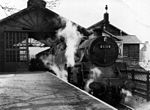Hutton Gate railway station
Hutton Gate was a railway station on the Middlesbrough and Guisborough Railway. It was opened on 25 February 1854 and closed along with the entire Nunthorpe-Guisborough branch on 2 March 1964. The station stands on Hutton Lane, just east of its junction with The Avenue. Originally, the station was exclusively for the use of the Pease family at the nearby Hutton Hall; the family owned the major iron ore mines in the region at the time and the railway line was designed to service these mines. Although a private station, excursion traffic was allowed to detrain at Hutton Gate, such as Liberal Association specials from Thornaby in the 1890s. These were run for a speaking event held in a marquee on the lawn outside Hutton Hall.The station was closed between May 1864 and July 1881, and then again from October 1903 to January 1904. It was purchased from the Pease family by the North Eastern Railway (NER) in 1904, and opened for public use. It served Hutton Village and, later, the Guisborough suburb of Hutton Lowcross. The station had its staffing withdrawn in 1961, and was listed for closure in March 1963. Full closure to all traffic came in March 1964.Following the branch's closure, the track was removed but the station remains intact and is now a private house. The modern road Pease Court begins where the station's level crossing once gave access to Hutton Hall.
Excerpt from the Wikipedia article Hutton Gate railway station (License: CC BY-SA 3.0, Authors).Hutton Gate railway station
Hutton Lane,
Geographical coordinates (GPS) Address Nearby Places Show on map
Geographical coordinates (GPS)
| Latitude | Longitude |
|---|---|
| N 54.5248 ° | E -1.0765 ° |
Address
Hutton Lane
Hutton Lane
TS14 8BG
England, United Kingdom
Open on Google Maps








